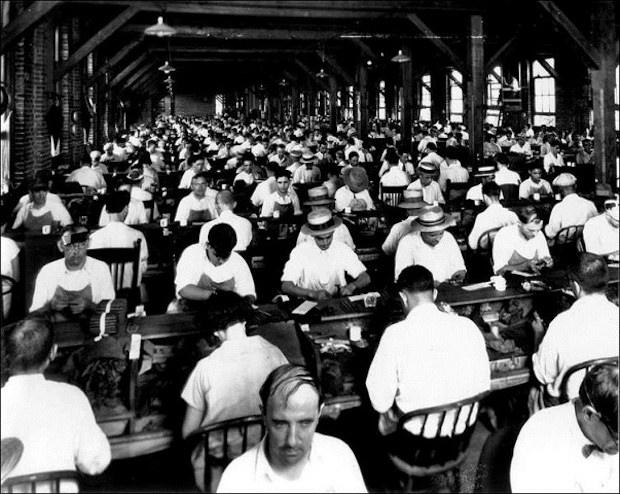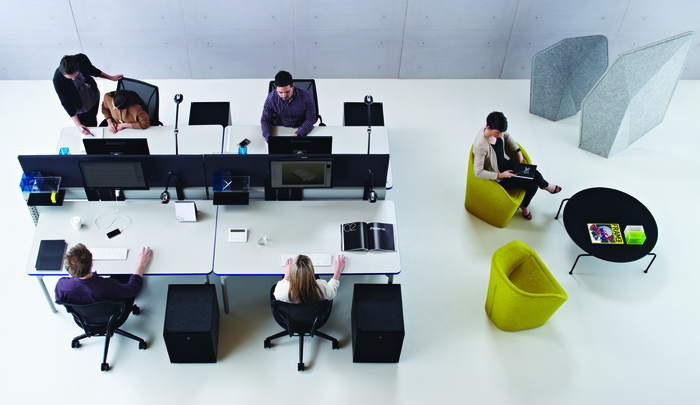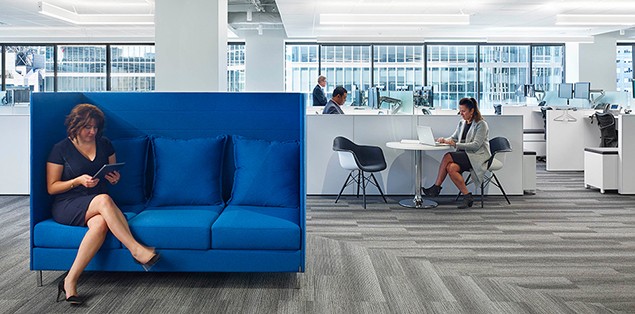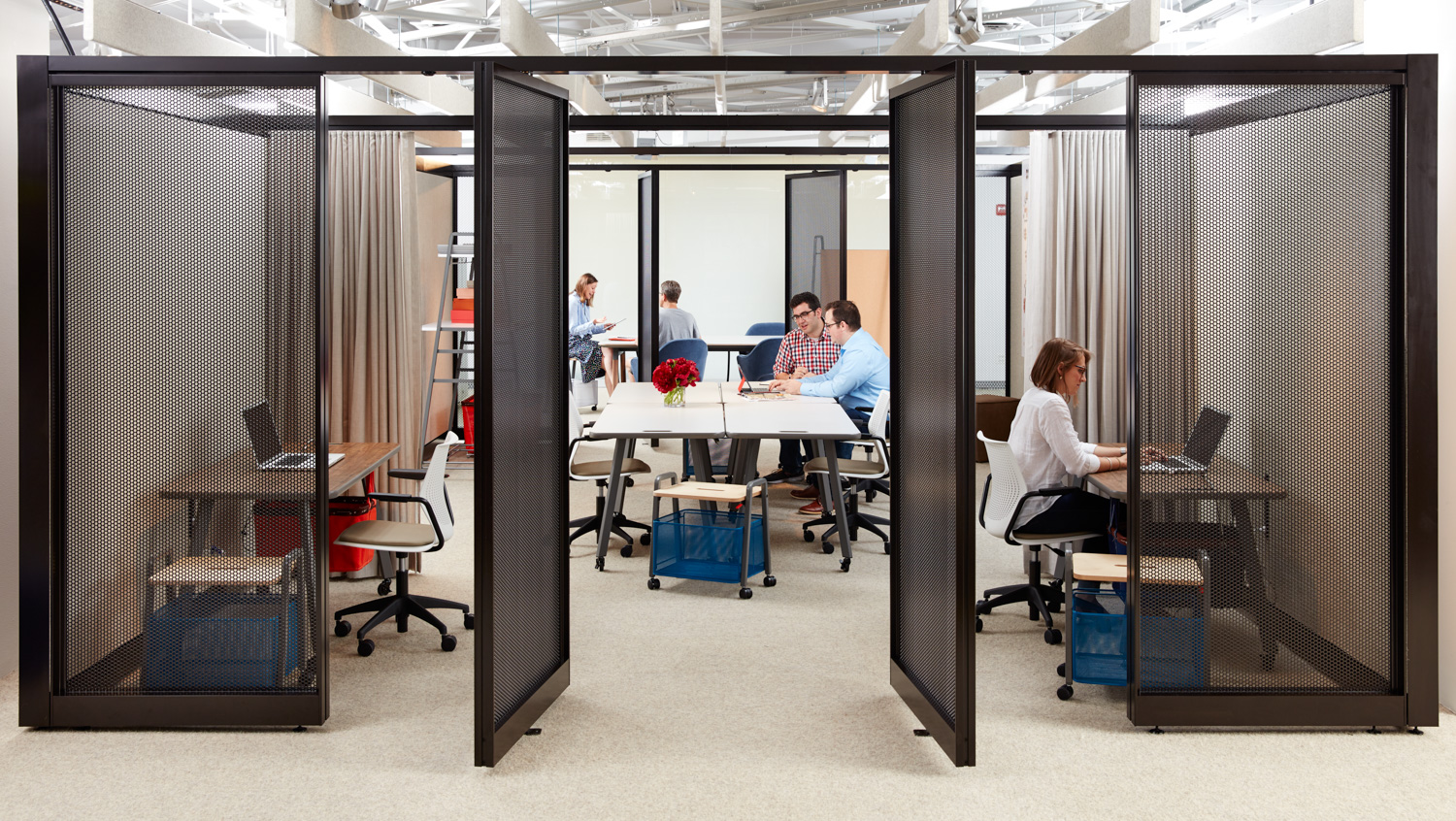The Future of Workplace is Not the Open Plan Office
In early 2000s the open plan workplace was the first choice all large companies with hundreds of employees jumped to.
Latest research and statistics have shown that although it seemed to be a good idea at the time, open plan offices are now proved to be toxic for your employees and bad for business.

image source: k2space.co.uk
The open-plan offices are bad for your employees and your business
Here are the statistics supporting this conclusion:
- Open plan offices don’t boost interaction and collaboration between employees as imagined: there is 73% less time in face-to-face interactions while email and messaging use shoots up by over 67% (inc.com);
- Businesses register low productivity due to the ambient noise present in office environments, employees suffer greater instances of conflict, higher blood pressure and a larger number of sick days (europeanceo.com);
- Employees’ ability to focus and concentrate on their work is compromised, losing a total of 86 minutes every day to distractions (europeanceo.com) which leads to inefficiency and mistakes.
The open-plan offices generate increased business costs due to decreased productivity of disengaged and unhappy employees.
The open plan offices are the past. What’s the future of workplace?
Designers and workplace strategists have four new and better-suited work environments for businesses and large companies to help them move beyond the open plan offices.
Here they are via Work Design Magazine.com:
- Activity-Based Workplaces (ABW)
- Neighbourhood-based Choice Environments (NCE)
- Maker Environments, Mobile Occupants (MEMO)
- Immersive Environments
Activity-Based Workplace

image source: officesnapshots.com
This office concept creates task-oriented solutions that encourage movement and empower people to select the right space for the job at hand.
ABW environments are typically designed to be an ecosystem of spaces, primarily grouped to serve four major work functions: solo work, collaboration, learning, socializing and rejuvenation.
Neighbourhood-Based Choice Environments

image source: workdesign.com
These spaces create a neighbourhood or home for teams to operate out of while still allowing people to have access to a variety of work settings. Having a team base where employees can connect and have a sense of belonging and identity is important to all.
NCE spaces create a sense of community and place that meets our territorial instincts. These environments enable people to connect by providing them with a variety of preferences while meeting the needs of the business and the individual.
Maker Environments, Mobile Occupants

image source: hok.com
MEMO spaces are emerging for companies that are looking to create innovative spaces that foster creativity and speed to innovation. Simply put, it’s the “garage-ification” of space for programmers, creatives, or co-workers where space takes on a scrum or maker feel.
These spaces are emerging in sectors where rapid development is key. In Asia they are often referred to as “agile program space”.
Immersive Environments

image source: workdesign.com
Immersive Environments pull the best lessons learned from work spaces—including open plan, co-working, ABW, NCE, and MEMO—and tailor them to meet the specific needs of a company.
They are less about what is trending and more focused on desired functions, outcomes, and creating compelling places.
Conclusion
Bob Fox, founder and CEO of FOX Architects has the following wise conclusion:
“The idea that ‘one size fits all’ when it comes to work environments is dead. The workplace design industry is filled with over simplified conversation about open vs. closed plan offices, and the truth is, it’s all irrelevant. It’s born out of a cost reduction mentality that permeates much of corporate America.
Cost is important, but it should not be the driver.
The workplace and all of its accoutrements have to support the leadership goals of the organization first.
Space is in many ways similar to fashion or technology – things go in and out of style all the time. What’s actually important to understand is that each organization is different and has a set of unique requirements needed to achieve maximum performance. And their space should appropriately reflect that.”
The future, closer to us than we might think

Tianjin Eco-City of the Future
By 2045, the futurists, quoted by dailymail, foresee ‘talking’ buildings, windows being replaced by augmented reality screens and self-healing, self-driving planes. Moreover, one expert believes we may even ditch technology completely and go back to pens and paper, while another predicts candles and incense sticks will become heavily regulated over health concerns.
The predictions have been made by artificial intelligence specialists, roboticists and futurologists from Australian universities as well as experts from UK-based plant hire company Hewden. Him, with futurologist Dr Ian Pearson, particularly focused on how buildings will adapt over the next 30 years. By the middle of the century, Dr Pearson believes buildings will have artificial intelligence ‘personalities’ and will be able to ‘talk’ to people. Homes and offices will collect and process data from various sensors to flag up when repairs are needed or when the heating needs to be turned on.
But some innovations are already here, surprising us. Sony is one of the brands that keeps on giving, on several areas and industries. The brand has recently announced a new series of SD cards it is touting as “ the world’s fastest.” The maximum write speed for the SF-G series will soar up to 299 MB/s, while the read speed will hit 300 MB/s. “For comparison, Amazon’s current bestselling SD card can only handle 80 MB/s read and write speeds. The cards will be available in 32GB, 64Gb, and 128GB variations. Part of this increase in speed capability is thanks to the cards’ support of the UHS-II interface, which means the cards sport an extra row of connecting pins for better transfer speeds. Sony has yet to announce pricing for these speedy cards, but they have listed them as being available as soon as Spring 2017,” writes Futurism.com.
According to Business Insider, Ford of Spain collaborated with Espadaysantacruz Studio to create a crib that simulates the conditions of driving to put your baby to sleep. Called the “Motor Dreams” crib, it was created for an ad campaign for their MAX models. It features sounds of an engine, gentle movement imitating traffic, and LED lights that mimic street lights. It’s all controlled by a smartphone app that can reproduce your car’s movement. Ford is thinking more about a real production model. The crib will be given away in a raffle.
A skin-like biomedical technology that uses a mesh of conducting nanowires and a thin layer of elastic polymer might bring new electronic bandages that monitor biosignals for medical applications and provide therapeutic stimulation through the skin. The biomedical device mimics the human skin’s elastic properties and sensory capabilities.
“It can intimately adhere to the skin and simultaneously provide medically useful biofeedback such as electrophysiological signals,” said Chi Hwan Lee, an assistant professor of biomedical engineering and mechanical engineering at Purdue University. “Uniquely, this work combines high-quality nanomaterials into a skin-like device, thereby enhancing the mechanical properties.” You can read more at: https://phys.org/news/2016-11-biomedical-skin-like-bandage-stretchy-durable.html#jCp
What we can for sure see is that the future really looks beautiful. Let’s hope it will also make us happy.










